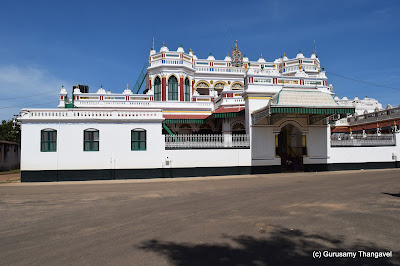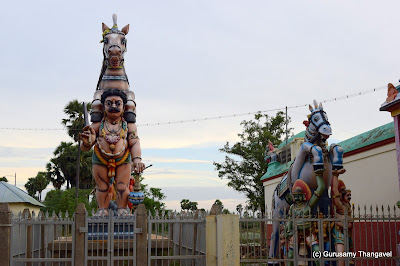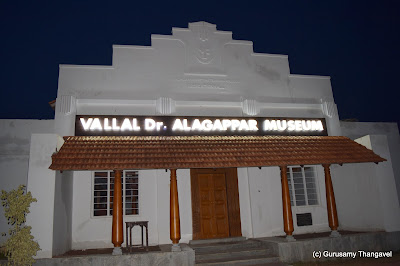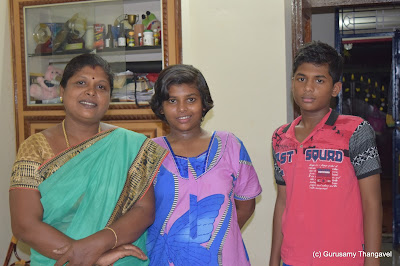Part 2: Day 1, (03/09/2016), afternoon
Selva, before leaving to Tirunelveli, had arranged one of his
close friends, a physical education teacher called Mr. Veera Sekar, to take me to
Chettinadu houses as I need a local person to access the houses. Selva had
earlier told me that I can take rest for some time and would request Mr. Sekar
to take me around 3.30 PM. When I was taking lunch, Selva called me that Mr.
Sekar would come in another few minutes as Sekar felt that starting at 3.30 PM
is too late to cover Chettinadu houses. But, I thought why one would need more
than 3 hrs to see those houses. However, later I regretted having thought like
that as even one day is not enough to cover these houses; such was the grandeur
of those palatial mansions, which you would appreciate in my photographs. Before
I had finished the lunch, Sekar came down. So around 2 PM, we started to Kanadukathan, a tiny village from
where many industrialists and philanthropists came from. Let me say some
history about the Nagarathar or Nattukottai Chettiyar community.


This is a small community of around a few lakhs people who
played a crucial role in shaping the modern development of India in general and
TN in particular in many aspects. They are basically a trading and business
community. Their ancestral area of living is called Chettinadu which is now
comprised of 74 villages in present day Sivaganga district. There are 9 clans
in this community and each clan has a separate identity through their clan
specific temples. This community has been involved in several businesses, notable
among them are Finance (Cholamandalam fin), Sanitaryware (Parryware), Sugar
(EID Parry), Cycles (TI cycles – Hercules and BSA), Petrochemcials (SPIC),
Cinema (AVM Productions), Cement (Chettinadu cement), Coffee plantations,
Logistics, Media and Publications (Kumudam, Vanathi, Palaniappa etc) and many
other businesses. Indian overseas, bank, Indian bank and Bank of Madura were
started by them and later taken over by government of India. Notable
educational institutions established by this community are Annamalai, Alagappa
and Chettinadu Universities, Thiagaraja Engineering as well as arts and science
colleges across Tamil Nadu and many schools. Former Finance minister P. Chidambaram
belongs to this community. The Chepauk cricket stadium is built by MA Chidamabram
and whose name the stadium is called now. There are many other laurels, but,
for the sake of time I have mentioned only a few.



According to their history, they were the leading community of
traders in Gems during the early Chozha period around 200 BCE to 400 CE, in the
erstwhile coastal city of Kaviripoompattinam, which is now underneath the sea.
During the medieval period they had left the Chozha kingdom and settled in
Pandya kingdom in the present day Chettinadu region. They claim that the main
characters of Silapathikaram (One of the five epics of Tamils) – Kovalan and
Kannagi belonged to their community. These show how wealthy they have been
since time immemorial. The early British documents, in the 17thcentury,
showed that they were involved in salt trading and were rich. During the 18th and
19th centuries they started doing businesses in Burma, Vietnam,
Thailand, Malaysia, Singapore, Indonesia, China and Srilanka. Particularly
their money lending business in Burma (Myanmar) was very popular and Burmese
believed in them rather than the British banking system, such was the business
ethics they possessed. During that period they started constructing palace like
houses in Chettinadu with Burmese teakwood, Belgium glass, Italian marble and
British iron. This is how Chettinadu became popular. The community is highly
philanthropic in nature. They have donated freely to many temples and
educational institutions. Major temples in India, particularly saivite temples
like Kasi Viswanatha, Madurai Meenatchi, Chidambaram and many more were
enriched by their donations. When India was under British rule, these people
made sure that the day to day functions of the Hindu temples were not affected.
They also did lot services to Tamil culture, music and drama. One person named
AK Chettiyar, who was so moved by Gandhiji sold all his properties; bought a
video camera in 1930s; learnt all the techniques of shooting with a camera and
went along with Gandhiji, wherever he had gone (both within and outside India),
with his own money and documented everything.




Now most of the chettiars have settled elsewhere and hence some
of the houses are abandoned and made to crumble. The exquisite materials of the
palatial mansions are being sold in Mumbai and Jodhpur markets. The streets are
deserted. Only during the festival time or when there is a function in the
family they come to Chettinadu. Some of them still keep the tradition of
conducting their marriage functions in their ancestral houses. All the family
members, wherever they are in the globe, should come together and celebrate it
in a traditional way. Hence, most of the days this area is devoid of people.
Only the manager and a watchman stay there. Now there are attempts to safeguard
this area, for its cultural importance, with the help of UNESCO. There are
plans to make this area as a tourist spot like Rajasthan. Some houses are being
converted as five star heritage hotels. The second house I visited, the
Chettinadu mansion, has been converted as a heritage hotel. One night stay here
would cost 7,000 rupess!
Sekar took me to the street of Chettinadu palace, which belongs
to M.A.M Ramasami’s family, whose grandfather established Annamalai University;
I fell in love with the house at first sight. There were both Indians and
foreigners trying to enter inside the house to take photographs, but the
security was refusing to allow them. Hence, Sekar took me to his sister’s house
which is a few streets away. Kanadukathan has full of palatial mansions. But
the biggest one is the M.A.Ms and that’s why
it is called a palace (Aranmanai). Sekar’s sister has been living in a rented
house. While going there, Sekar described that his sister’s house has one big
hall and a room. So I was causally imagining a big hall. As we entered inside
the house only I realized that I had not imagined that much big hall. It was
beyond my imagination. To surprise me further, Sekar said that this is not the
main hall. This is only a bojana hall (Dining hall) and the main house is
adjacent to that. After taking photographs we entered the main house. As the
owener’s of the house has come, I insisted Sekar’s sister to get permission to
enter inside the house, although she was telling they won’t object to it. They allowed
me inside and also gave permission to take photographs.



Typically a Nagarathar’s house is built on a high plinth,
usually five feet above from the street level. The basement upto the plinth
level is constructed with Laterite stone (செம்பராங் கல்), a naturally available stone of that region.
On top it, brick wall is constructed with lime mortar. While, outside of the
wall has just plain lime plastering, the inner walls are plastered with lime
mixed with egg white to get a shiny and smooth surface. Even modern day putty
and white cement cannot be a match for this vernacular technique. All the
houses have well planned rain water harvesting systems as Chettinadu’s annual
rainfall is around 800 mm. Moreover, the houses have good ventilation, passive
cooling mechanisms and diffusive natural lighting from the Sun etc. Modern day
gold and platinum ratings of the so called eco architecture are no way a match
for the indigenous technique of our traditional masons.




Typical nagarathar house has a high narrow entrance which leads
to the outer courtyard. A passage (நடைபாதை) leads to a high raised platform called
“Thinnai” (திண்ணை) which is both sides of the main entrance. Main entrance is made
up of fine quality Burma teak with exquisite carvings on top it. The doors of
the main entrance opens to the main hall which often has a double height
ceiling (20 ft height) so that the hall is always cool even during peak summer
periods with ventilators on top of it for the hot air to escape. The floor is
often made up of Italian marbles or Athangudi tiles, a locally handmade tile.
Another door opens to the semi open area called inner courtyard where usually
marriage functions are held which is surrounded by a corridor which contains
lot of rooms for each individual of the house. The pillars and beams of the
houses are often made up of Burma teak or British iron or polished granite.
Depends upon the wealth of the family there may be more than 2 courtyards in a
house besides a separate bojana hall. Usually the kitchen is in the second or
third courtyard. A door in the kitchen area leads to the backyard which has a
door, which opens to the next street. Courtyards play a crucial role in
maintaining the thermal comfort of the house; it also gives diffuse lighting to
the surrounding areas and aids in cross ventilation.
After thanking the house owners we started walking to seek
permission to enter into the Chettinad palace. On the way to the palace, I
clicked some more mansions from outside. Sekar’s sister knows the manager of
the palace well and hence she volunteered to help me in getting permission to
access the palace. On the way to the palace, the Chettinadu mansion is
situated, which has been converted as a heritage hotel. She said she can take
me inside that hotel too. After having made to wait for few minutes, we were
granted permission. Some high profile guest had come which was the reason we were
made to wait was the reason given to us. I didn’t mind all these things as I am
fully immersed in the beauty of that mansion. After I had taken enough photos
Sekar and his sister took me to the palace, the place where I was longing to
see for several years. After some initial dialogues, the manager/accountant
allowed us inside. The security also came along with us. True to its name the
mansion is a palace. In the main hall I could see the portraits of recently
demised M.A.M Ramasamy and his wife on one side and the other side his father,
grandfather’s portraits are placed. Two pairs of elephant tusks are displayed
on two sides of the hall. I remember I saw three courtyards. The last one where
the Kitchen area is present is a huge one. The security did not allow us to
enter into the bojana hall and first floor. After thanking the manager,
security and Sekar’s sister, we both headed to Aathankudi.



Aathankudi, another village in Chettinadu region, seemed to be bigger
than Kanadukathan. The house where Sekar took me is famous for cinema shooting.
The accountant asked me 50 rupees (just 50 rupees) to enter into the house.
This is a smaller house compared with the palace. But for our standards it is
another palace. I took lot of photos here. Then we headed to an Aathankudi tiles
manufacturing company. This is a cement tile manufactured in this village and
hence called Aathankudi tiles. These are all hand made with cement mortar and
glass. They will make different designs and in different colours according to
our choice. Since, it was a holiday for the factory we could not see the
manufacturing process, but, the owner kindly allow us inside. He even sent his
manager to explain the process. There were artisans working on a wood carving.
I took a photo of it. When we were just getting out of Aathankudi, I saw a
beautiful shiva temple with a large temple tank which has half filled with rain
water. I wanted to take photographs and so we stopped there. The tank has
elaborate methods to capture rain water. In fact throughout the Chettinadu
region I could see these kinds of temple tanks. Then we headed to Pallathur,
another Chettinadu village. On the way to Pallathur, outside of Aathankudi, I
saw lot of depleted Nagarathar houses getting crumbled.



Pallathur is relatively greener than Kanadukathan. Sekar said
there are 3 to 4 Kanmais (Lake like water bodies) around this village and
that’s why it is greener. He works in this village elementary school and hence
many people on the way wished him. Pallathur is the ancestral village for
another south Indian conglomerate, the Murugappa group. As it was getting dark,
we did not stop anywhere, but I keep taking photos from the billion when Sekar
was riding the motorbike. Then we went to Kottaiyur, the village where Alagappa
University founder Dr. Alagappa Chettiyar lived. We took a photograph of his
house. AK Chettiyar also belonged to this village. On returning to Karaikudi I
saw Alagappa University and CECRI campuses. More than 1000s of acres of land
was donated by Alagappa Chettiyar for the cause of education. 1950s, he met
Nehru and donated 350 acres and 15 lakhs (remember in 1950s) for CECRI. Nehru
praised him as the “socialist capitalist”. He established several schools,
engineering colleges, arts and science colleges etc. He donated all his wealth
he earned from his various ventures like, textile mills in Cochin, insurance
business in Kolkatta, Shipping businesss in Mumbai and Coffee plantations in
Coorg, rubber estates in Malaysia, for the cause of education. But
unfortunately he died at the tender age of 47. I did know that Alagappa
Chettiyar established the educational institutions, but the magnitude was not
known to me until Sekar told this to me while riding his bike. I verified it
through Google too.




Sekar took me to his sports academy where he along with few of
his other friends are teaching hockey to school kids, free of cost inside the
Alagappa University grounds. Two of his friends, both named Kumaran, were there
and he introduced me to them. The kumaran with a beard is an architect who is
interested in vernacular architecture and is building a museum for Alagappa
Chettiyar. He also helps 15 poor children for their education. Sekar took me to
the museum, which has a typical Chettinadu style architecture. There is a semi
open amphitheatre inside which is surrounded by corridors. The museum is not
fully inaugurated yet.



On the way to Selva’s house, Sekar took me to a restaurant named
– New president hotel. It is a semi open restaurant with temporary roofs. Sekar
told that the owner is an interesting person. Whatever, the customer says he
will only bill for that; He won’t suspect the customer. Moreover, if the
customer says no money to pay he would say OK. All his employees are paid
Rupees 700 per day and given welfare measures too. It reminded me of
Jeyamohan’s short story “Sottru kanakku” which told to Sekar. There are still a
lot people like him in India. I was reluctant to eat full dinner, since Ganka
kept calling me from her clinic that I should eat dinner at their house. But
Sekar already ordered parrotta for each of us. I stopped eating parotta few
years back. However, it was very tasty and then he told me to taste fried
idiappam and then finally a garlic dosa; thus I ate a full dinner. When we
reached Selva’s house, Ganka also came in by that time and after thanking them
I left for Devakottai, another prominent town in Chettinadu area where my close
friend Dr. Mariappan lives.
I along with Mariappan and 3 other friends stayed together
during our five and half years of UG days. After about 45 minutes travel, I
reached Devakottai around 9.30 PM. I and Mariappan went for a walk and on the way he showed me some of the big Chettinadu mansions. AV Meiyapan
chettiyar, the founder of AVM studios belonged to Devakottai town. It was already 12 AM, by the time we slept and I had to get up 4.30 AM to
catch the bus to Kalayarkoil, a historical place, from there I wanted to go to my
colleague’s daughter marriage. Thus my first day travelogue is over.
More photos in Flickr


